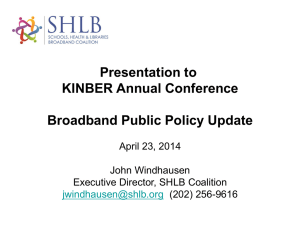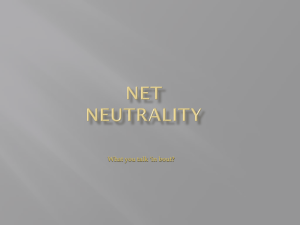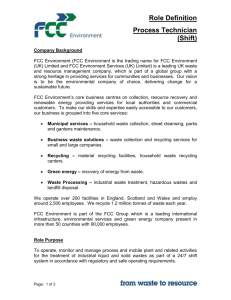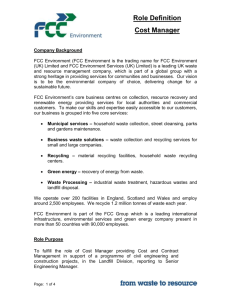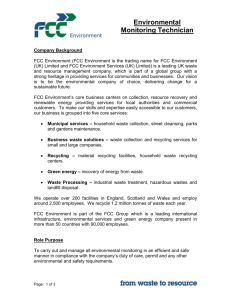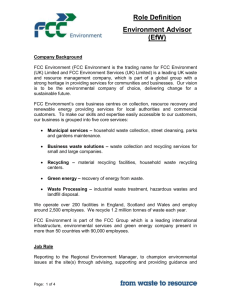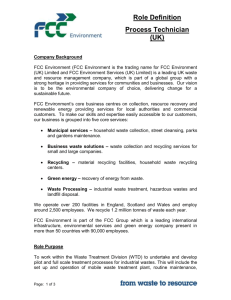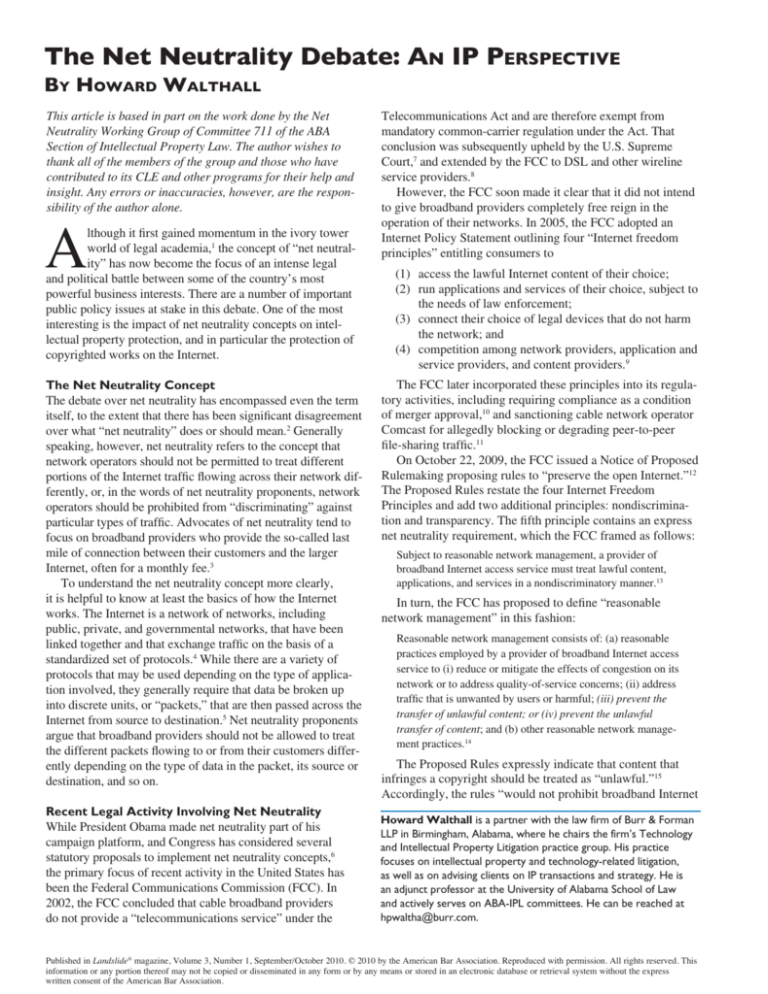
The Net Neutrality Debate: An IP Perspective
By Howard Walthall
This article is based in part on the work done by the Net
Neutrality Working Group of Committee 711 of the ABA
Section of Intellectual Property Law. The author wishes to
thank all of the members of the group and those who have
contributed to its CLE and other programs for their help and
insight. Any errors or inaccuracies, however, are the responsibility of the author alone.
A
lthough it first gained momentum in the ivory tower
world of legal academia,1 the concept of “net neutrality” has now become the focus of an intense legal
and political battle between some of the country’s most
powerful business interests. There are a number of important
public policy issues at stake in this debate. One of the most
interesting is the impact of net neutrality concepts on intellectual property protection, and in particular the protection of
copyrighted works on the Internet.
The Net Neutrality Concept
The debate over net neutrality has encompassed even the term
itself, to the extent that there has been significant disagreement
over what “net neutrality” does or should mean.2 Generally
speaking, however, net neutrality refers to the concept that
network operators should not be permitted to treat different
portions of the Internet traffic flowing across their network differently, or, in the words of net neutrality proponents, network
operators should be prohibited from “discriminating” against
particular types of traffic. Advocates of net neutrality tend to
focus on broadband providers who provide the so-called last
mile of connection between their customers and the larger
Internet, often for a monthly fee.3
To understand the net neutrality concept more clearly,
it is helpful to know at least the basics of how the Internet
works. The Internet is a network of networks, including
public, private, and governmental networks, that have been
linked together and that exchange traffic on the basis of a
standardized set of protocols.4 While there are a variety of
protocols that may be used depending on the type of application involved, they generally require that data be broken up
into discrete units, or “packets,” that are then passed across the
Internet from source to destination.5 Net neutrality proponents
argue that broadband providers should not be allowed to treat
the different packets flowing to or from their customers differently depending on the type of data in the packet, its source or
destination, and so on.
Recent Legal Activity Involving Net Neutrality
While President Obama made net neutrality part of his
campaign platform, and Congress has considered several
statutory proposals to implement net neutrality concepts,6
the primary focus of recent activity in the United States has
been the Federal Communications Commission (FCC). In
2002, the FCC concluded that cable broadband providers
do not provide a “telecommunications service” under the
Telecommunications Act and are therefore exempt from
mandatory common-carrier regulation under the Act. That
conclusion was subsequently upheld by the U.S. Supreme
Court,7 and extended by the FCC to DSL and other wireline
service providers.8
However, the FCC soon made it clear that it did not intend
to give broadband providers completely free reign in the
operation of their networks. In 2005, the FCC adopted an
Internet Policy Statement outlining four “Internet freedom
principles” entitling consumers to
(1) access the lawful Internet content of their choice;
(2)run applications and services of their choice, subject to
the needs of law enforcement;
(3) connect their choice of legal devices that do not harm
the network; and
(4) competition among network providers, application and
service providers, and content providers.9
The FCC later incorporated these principles into its regulatory activities, including requiring compliance as a condition
of merger approval,10 and sanctioning cable network operator
Comcast for allegedly blocking or degrading peer-to-peer
file-sharing traffic.11
On October 22, 2009, the FCC issued a Notice of Proposed
Rulemaking proposing rules to “preserve the open Internet.”12
The Proposed Rules restate the four Internet Freedom
Principles and add two additional principles: nondiscrimination and transparency. The fifth principle contains an express
net neutrality requirement, which the FCC framed as follows:
Subject to reasonable network management, a provider of
broadband Internet access service must treat lawful content,
applications, and services in a nondiscriminatory manner.13
In turn, the FCC has proposed to define “reasonable
network management” in this fashion:
Reasonable network management consists of: (a) reasonable
practices employed by a provider of broadband Internet access
service to (i) reduce or mitigate the effects of congestion on its
network or to address quality-of-service concerns; (ii) address
traffic that is unwanted by users or harmful; (iii) prevent the
transfer of unlawful content; or (iv) prevent the unlawful
transfer of content; and (b) other reasonable network management practices.14
The Proposed Rules expressly indicate that content that
infringes a copyright should be treated as “unlawful.”15
Accordingly, the rules “would not prohibit broadband Internet
Howard Walthall is a partner with the law firm of Burr & Forman
LLP in Birmingham, Alabama, where he chairs the firm’s Technology
and Intellectual Property Litigation practice group. His practice
focuses on intellectual property and technology-related litigation,
as well as on advising clients on IP transactions and strategy. He is
an adjunct professor at the University of Alabama School of Law
and actively serves on ABA-IPL committees. He can be reached at
hpwaltha@burr.com.
Published in Landslide® magazine, Volume 3, Number 1, September/October 2010. © 2010 by the American Bar Association. Reproduced with permission. All rights reserved. This
information or any portion thereof may not be copied or disseminated in any form or by any means or stored in an electronic database or retrieval system without the express
written consent of the American Bar Association.
access service providers from taking reasonable action to
prevent the transfer of unlawful content, such as the unlawful
distribution of copyrighted works.”16
The Players and Their Positions
The FCC received extensive comments on the Proposed Rules
from a number of interested companies and groups, including
the Open Internet Coalition (representing Amazon, Facebook,
Skype, Netflix, Ticketmaster, Google, and others),17 Arts +
Labs (representing AT&T, Verizon, Viacom, NBC Universal,
BMI, ASCAP, Microsoft, and Cisco, among others),18 and
the Songwriter’s Guild of America, as well as public interest groups such as the Electronic Frontier Foundation, Free
Press, and Public Knowledge. Many of these comments were
directed, in whole or in part, to the impact of the Proposed
Rules on copyright protection on the Internet.
The parties actively involved in the debate tend to fall into
three loosely defined camps.19 The perspectives and commercial interests of these three groups have largely defined the net
neutrality debate as it currently stands.
First, the broadband providers argue that net neutrality regulations are unnecessary because there is no need for such regulation. Consumer choice and market pressures will provide an
appropriate level of protection for consumers. According to their
arguments, government regulation in this area will serve only
to interfere with their ability to effectively manage and protect
their networks, and will stifle continued innovation and improvement in the services available to consumers over the Internet.20
Broadband providers contend that the extent to which they
attempt to identify or block allegedly infringing material should
be left in their discretion, along with all of the other day-to-day
network management decisions they must make
Second, companies involved in “content creation” industries, including music, movies, television, and to some extent
software, maintain that net neutrality in general, and the
Proposed Rules in particular, are harmful to the extent they in
any way restrict the ability of broadband providers, in collaboration with content owners, to take voluntary measures to
deter potentially infringing activity.21 In particular they point
to peer-to-peer file-sharing applications as a significant culprit,
arguing that as much as 90 percent of peer-to-peer traffic on the
Internet is infringing.22
Third, companies that provide applications and services
over the Internet, along with certain public interest groups,
tend to favor net neutrality regulation. These groups argue that
broadband providers should not be allowed to give preferential
treatment to their own content, or to content provided by their
business partners, as this would create a “pay to play” system
that would disrupt the development of new Internet technologies and businesses.23 They have expressed concerns that
broadband providers may interpret the “reasonable network
management” exception in the Proposed Rules to allow the
blocking or filtering of lawful content based on the pretext of
preventing the transfer of actual (or even suspected) “unlawful
content.”24 They contend that unilateral blocking or filtering of
content by broadband providers would disrupt the delicately
balanced provisions of the Digital Millennium Copyright
Act (DMCA), which includes notice, “take down,” and
counter-notice provisions to protect the interests of copyright
owners, service providers, and users.25 They also argue that
there is insufficient competition in the broadband market in
most areas for consumer choice to prevent abusive conduct.26
The Hot Button Issues
While these three camps debate the propriety of net neutrality
regulation generally, in the IP arena there are two related issues
around which the debate has swirled the most vigorously.
Deep Packet Inspection and Filtering
Assuming that broadband providers are allowed, under the
FCC’s fifth principle or the reasonable network management
exceptions, to block or otherwise take measures to address
infringing content on their networks, the question becomes how
such content can be accurately identified. One potential answer
lies in a filtering technology known as deep packet inspection,
or DPI. DPI describes a process in which the network’s equipment looks beyond the addressing information (called a header)
usually used to direct a packet on to its destination and evaluates the actual contents of the data packet, or even a stream of
related packets.27 Combining DPI with content identification
software designed to identify particular copyrighted audio or
video works might allow broadband providers to identify and
filter out infringing content flowing through their networks.28
The possible use of DPI for this purpose has caused an
outcry from net neutrality advocates.29 They argue that DPI
involves a significant invasion into the privacy of the communications being carried over the Internet, tantamount to the
Post Office opening and reading people’s mail. They also point
out that the use of DPI could violate the federal Electronic
Communications Privacy Act (ECPA) and analogous state
statutes.30 Furthermore, DPI and similar filtering systems may
have difficulty identifying instances of the lawful fair use of
copyrighted works, running the risk that this category of lawful content could be inadvertently blocked.31
While some content creation groups have advocated the
use of DPI filtering in certain circumstances,32 most involved
in the debate (including some broadband providers) acknowledge the difficulties involved. Content identification technology is itself in a fairly early stage of development.33 The
systems that have been developed to date have primarily been
designed to crawl relatively static repositories of data, including content hosting sites like YouTube, or to monitor smaller
private networks.34 It could be immensely more difficult and
expensive for a broadband provider to implement such a system to review Internet traffic arriving across multiple network
access points in real time without significantly slowing down
the traffic itself. Additionally, such a filtering system may be
unable to review traffic that is encrypted, making encryption
an easy solution for those interested in distributing unlawful
infringing content and evading detection.
Affecting Lawful Content
The above issues may make it very unlikely that a robust DPI
filtering system can or will be implemented by broadband
providers, at least in the near term. The likely reality, therefore,
is that if a broadband provider were to decide to take action
Published in Landslide® magazine, Volume 3, Number 1, September/October 2010. © 2010 by the American Bar Association. Reproduced with permission. All rights reserved. This
information or any portion thereof may not be copied or disseminated in any form or by any means or stored in an electronic database or retrieval system without the express
written consent of the American Bar Association.
affecting particular traffic because of copyright concerns, it
would not be able to determine whether each piece of this traffic was infringing. The initial decision might have to be made
on other grounds, for example, the type (e.g., peer-to-peer) and
source of the traffic, as well as evidence (typically provided
by content owners) that the source in question had historically
been associated with a significant amount of infringing content.
Given these looser parameters, it would be at least possible, if
not likely, that some lawful content could be included within
the traffic affected.
Whether broadband providers should have the flexibility to
make such decisions, as part of “reasonable network management” or otherwise, or should instead be strictly prohibited
from blocking, filtering, or otherwise affecting lawful content
in any way, is one of the key issues at stake in the net neutrality debate. For the reasons already discussed, most broadband
providers and content creation companies argue that this type
of flexibility is necessary to protect the networks and prevent
widespread copyright piracy. Internet service providers and
public interest groups counter that such a high degree of
flexibility should not be permitted and could be misused in
order to favor the offerings of the broadband providers and
their business partners over those of competing businesses that
consumers may otherwise prefer.35
Jurisdictional Issues and the Comcast Decision.
It remains to be seen how the FCC will resolve these issues,
and even whether the FCC will be allowed to make the final
determination. Indeed, recent events have cast the FCC’s
jurisdiction in this area into doubt.
According to the FCC, the Proposed Rules rely on much
the same jurisdictional basis that supported the agency’s
Internet Policy Statement and the subsequent enforcement
of these policies.36 Specifically, while acknowledging that
Congress has not given it specific direction to regulate broadband Internet providers, the FCC contends that the Proposed
Rules are within its “ancillary jurisdiction.”37 However, the
Court of Appeals for the District of Columbia Circuit recently
overturned the FCC’s decision applying the Internet Policy
Statement in the Comcast matter, concluding that the FCC
lacked jurisdiction to regulate Comcast’s network management practices.38 Because of the similarity of the jurisdictional
bases upon which the FCC has relied in issuing its Proposed
Rules, the Comcast decision may pose a significant barrier to
the implementation of those rules.
What will happen next is uncertain. The FCC has a variety
of options open to it. It could reevaluate its Proposed Rules and
their jurisdictional bases, and propose modified (and likely narrower) rules. Or it could seek to revisit its previous decision and
reclassify broadband service as a “telecommunications service,”
subject not only to FCC jurisdiction but to mandatory commoncarrier regulations under the Telecommunications Act.
At least for now, it appears that the FCC will take what it
considers a “middle ground.” On May 6, 2010, the chairman
and general counsel of the FCC announced that, in response to
Comcast, they will recommend that the FCC move to reclassify broadband as a Title II regulated “telecommunication
service,” but only in part.39 Specifically, they recommend that
the FCC reclassify the “transmission component” of broadband as a “communications service,” while maintaining all
other aspects, including applications or content provided over
the Internet, as an “information service” not subject to Title II.
Furthermore, they propose that the FCC exercise its statutory
authority to forbear40 from the application of most of the Title
II statutory requirements to broadband service, applying only
the most “fundamental” requirements.
Among these would be included the provisions of § 202 of
the Communications Act, barring any common carrier from
making
any unjust or unreasonable discrimination in charges, practices,
classifications, regulations, facilities, or services for or in connection with like communication service, directly or indirectly,
by any means or device, or to make or give any undue or
unreasonable preference or advantage to any particular person,
class of persons, or locality, or to subject any particular person,
class of persons, or locality to any undue or unreasonable
prejudice or disadvantage.41
This provision, if applicable, would appear to impose at
least some form of “net neutrality” restrictions on broadband
providers. In his statement, General Counsel Schlick indicated
that the FCC staff certainly views the provision this way,
indicating that the provision would have prohibited the “secret
interference with subscribers’ lawful Internet transmissions”
at issue in the Comcast matter.42 The details of the proposed
application of this provision to broadband services, including
the FCC’s views on what is and is not “unjust and unreasonable discrimination,” remain to be fleshed out. This discussion
will almost certainly bring to the forefront once again the
Internet copyright issues discussed above.
In order to follow its newly proposed path, the FCC must
retreat from its prior rulings concluding that broadband is a unitary “information service” not subject to Title II in any respect,
an interpretation that has already been upheld by the Supreme
Court.43 The announcements of the chairman and general counsel
were only the first step in this process. On June 17, 2010, the
FCC voted 3–2 to take the second step down this path, issuing
a notice of inquiry requesting public comment on the adequacy
of the FCC’s jurisdiction over broadband providers under the
existing legal framework, the consequences of reclassifying
broadband as a telecommunications service subject to Title II,
and the propriety of the proposed “third way” approach.
The period for public comment in response to the FCC’s
notice of inquiry is open as of this writing. In that process, there
is no doubt that those groups with strong views of net neutrality, both pro and con, will again make their voices heard. Those
who are unhappy with the FCC’s ultimate conclusions may
well seek judicial intervention, challenging the FCC’s proposed
new applications of the Communications Act provisions in the
broadband arena.44 In the meantime, Congress could step in to
definitively address the issue, either by defining the FCC’s proposed jurisdiction over broadband, imposing its own broadband
regulatory scheme, or both.45
At this point there is only one thing we know with certainty
about the net neutrality debate. It is far from over. n
Published in Landslide® magazine, Volume 3, Number 1, September/October 2010. © 2010 by the American Bar Association. Reproduced with permission. All rights reserved. This
information or any portion thereof may not be copied or disseminated in any form or by any means or stored in an electronic database or retrieval system without the express
written consent of the American Bar Association.
Endnotes
1.The concept was originally popularized by Tim Wu, a law professor at Columbia, along with Stanford law professor Larry Lessig
and others. See, e.g., Tim Wu, Network Neutrality, Broadband
Discrimination, 2 J. Telecomm. & High Tech. L. 141 (2003); Tim Wu,
The Broadband Debate: A User’s Guide, 3 J. Telecomm. & High Tech.
L. 69 (2004); Letter from Tim Wu & Lawrence Lessig to Marlene H.
Dortch, Secretary, Fed. Commc’ns Comm’n, Ex Parte Submission in
CS Docket No. 02-51, available at http://www.freepress.net/docs/wu_
lessig_fcc.pdf.
2.
See, e.g., Adam D. Thierer, “Net Neutrality” Digital
Discrimination or Regulatory Gamesmanship in Cyberspace, Policy
Analysis, no. 507 (Jan. 12, 2004), available at http://www.cato.org/
pubs/pas/pa507.pdf.
3.The term “last mile” refers to “the final leg of delivering connectivity from a communications provider to a customer.” The actual distance involved may be substantially more or less than a mile.
Broadband providers may provide last-mile connectivity by a variety of
means, including DSL, cable, and wireless technologies. See Last mile,
Wikipedia, http://en.wikipedia.org/wiki/Last_mile (last visited May 2,
2010).
4.
See Internet, Wikipedia, http://en.wikipedia.org/wiki/Internet#
Technology (last visited May 2, 2010). It should be noted that the exact
scope and definition of the “Internet” has itself been subject to debate.
5.
See id.; see also Internet Protocol Suite, Wikipedia, http://
en.wikipedia.org/wiki/tcp/ip (last visited May 2, 2010); Transmission
Control Protocol, Wikipedia, http://en.wikipedia.org/wiki/
Transmission_Control_Protocol (last visited May 2, 2010); Packet
(information technology), Wikipedia, http://en.wikipedia.org/wiki/
Packet_(information_technology) (last visited May 2, 2010).
6.
See, e.g., H.R. 5273 (The Network Neutrality Act of 2006); S.
215 (Internet Freedom Preservation Act); H.R. 3458 (Internet Freedom
Preservation Act).
7.Nat’l Cable Tel. Ass’n v. Brand X Internet Servs., 545 U.S. 967
(2005).
8.
See Appropriate Framework for Broadband Access to the Internet
over Wireline Facilities, FCC 05-150 (adopted Aug. 5, 2005).
9.FCC Internet Policy Statement, FCC 05-151 (adopted Aug. 5,
2005).
10.
See AT&T/BellSouth Merger Order, FCC 06-189, rel. Mar. 26,
2007 (“Effective on the Merger Closing Date, and continuing for 30
months thereafter, AT&T/BellSouth will conduct business in a manner
that comports with the principles set forth in the Commission’s Policy
Statement, issued September 23, 2005” (FCC 05-151)).
11.Comcast Order, FCC 08-183 (adopted Aug. 1, 2008), appeals consolidated sub nom. Comcast Corp. v. FCC (No. 08-1291).
12.Notice of Proposed Rulemaking, In re Preserving the Open
Internet, GN Docket No. 09-191, WC Docket No. 07-52 (adopted
|Oct. 22, 2009), available at http://hraunfoss.fcc.gov/edocs_public/
attachmatch/FCC-09-93A1.pdf [hereinafter Proposed Rules].
13.
Id. at ¶ 104.
14.
Id. at ¶ 135 (emphasis added).
15.
Id. at ¶ 139.
16.
Id. at ¶ 16.
17.
See http://www.openinternetcoalition.org.
18.
See http://www.artsandlabs.com.
19.This is not to say that the members of these camps are aligned
identically on all issues, as there clearly are differences in their respective positions. On the overarching issues, however, their views tend to
be aligned.
20.
See, e.g., Comments of Arts+Labs, In re Preserving the Open
Internet, GN Docket No. 09-191, WC Docket No. 07-52 (Jan. 11, 2010)
[hereinafter Arts+Labs Comments].
21.
See, e.g., Comments of The Songwriters Guild of Am., In re
Preserving the Open Internet, GN Docket No. 09-191, WC Docket No.
07-52 (n.d.) [hereinafter SGA Comments].
22.
Id. at 3.
23.
See, e.g., Comments of Elec. Frontier Found. at 3, In re Preserving
the Open Internet, GN Docket No. 09-191, WC Docket No. 07-52 (Jan.
14, 2010) [hereinafter EFF Comments].
24.
See, e.g., id. at 11–12; Comments of Google at 72–73, In re
Preserving the Open Internet, GN Docket No. 09-191, WC Docket No.
07-52 (Jan. 14, 2010) [hereinafter Google Comments]; Comments of
Open Internet Coalition at 52–53, In re Preserving the Open Internet,
GN Docket No. 09-191, WC Docket No. 07-52 (Jan. 14, 2010) [hereinafter OIC Comments].
25.
See, e.g., Google Comments, supra note 24, at 73; OIC Comments,
supra note 24, at 58–60 (citing 17 U.S.C. § 512).
26.
See, e.g., EFF Comments, supra note 23 at 3–4, 13.
27.
See Deep Packet Inspection, Wikipedia, http://en.wikipedia.org/
wiki/Deep_packet_inspection (last visited May 2, 2010).
28.DPI could similarly be used for other purposes, for example, in law enforcement, or in an attempt to identify and block child
pornography.
29.
See, e.g., OIC Comments, supra note 24, at 14, 66–67.
30.
See id. at 64–65 (citing 18 U.S.C. §§ 2510–2522).
31.
See EFF Comments, supra note 24, at 14–16; OIC Comments,
supra note 24, at 55–57, 63 (citing 17 U.S.C. § 107).
32.
SGA Comments, supra note 21, at 6.
33.
See id. at 5–6; see also Comment of Motion Picture Ass’n of Am.,
In re Broadband Industry Practices, WC Docket No. 07-52 (June 15,
2007).
34.
See, e.g., Mehan Jayasuriya et al., Forcing the Net Through a
Sieve: Why Copyright Filtering Is Not a Viable Solution for U.S. ISPs,
Public Knowledge, available at http://www.publicknowledge.org/
paper/pk-filtering-whitepaper (discussing products from Audible Magic
and Vobile, among others).
35.
See supra note 26.
36.
Proposed Rules, supra note 12, at ¶ 83. The FCC also claimed
authority to promulgate rules with respect to wireless broadband providers based on its power to regulate uses of the radio spectrum. Id. at ¶ 86.
37.
Id. at ¶ 83 (citing United States v. Sw. Cable Co., 392 U.S. 157,
172–73 (1968); United States v. Midwest VideoCorp., 406 U.S. 649, 662
(1972)).
38.Comcast v. FCC, No. 08-1291 (D.C. Cir. Apr. 6, 2010).
39.Julius Genachowski, FCC Chairman, Remarks, The Third Way:
A Narrowly Tailored Broadband Framework (May 6, 2010), available
at http://hraunfoss.fcc.gov/edocs_public/attachmatch/DOC-297944A1.
pdf); Austin Schlick, FCC General Counsel, Remarks, A Third-Way
Legal Framework for Addressing the Comcast Dilemma (May 6, 2010),
available at http://hraunfoss.fcc.gov/edocs_public/attachmatch/DOC297945A1.pdf.
40.
See 47 U.S.C. § 160; see also 47 U.S.C. § 1302 (directing the FCC
to use “regulatory forbearance,” among other measures, to “encourage
the deployment on a reasonable and timely basis of advanced telecommunications capability to all Americans”).
41.47 U.S.C. § 202.
42.Schlick, supra note 39, at 4.
43.
See supra notes 7 and 8.
44.The FCC will apparently argue that the Supreme Court’s decision
in Brand-X was based on Chevron deference to the FCC’s interpretation
of the communications laws, and that the FCC can issue a new interpretation, which will be likewise subject to deference. See Schlick, supra
note 39, at 5–7.
45.Similar net neutrality and online copyright issues are also in play
in other countries and internationally, including in the negotiation of the
proposed Anti-Counterfeiting Trade Agreement (ACTA). After much
public speculation about its terms, a working draft of ACTA has recently been released and is available at http://trade.ec.europa.eu/doclib/
docs/2010/april/tradoc_146029.pdf.
Published in Landslide® magazine, Volume 3, Number 1, September/October 2010. © 2010 by the American Bar Association. Reproduced with permission. All rights reserved. This
information or any portion thereof may not be copied or disseminated in any form or by any means or stored in an electronic database or retrieval system without the express
written consent of the American Bar Association.

